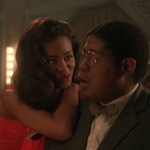 It’s that time of year again. The time when the sun comes out and my instincts tell me to crawl into a dark theater. It’s also become the time when I take a deeper look at summer movie entertainment of the past. Especially in this strange year, when the vaccines are starting to kick in but an immediate return to normal life seems unlikely, there’s something I find very comforting and fascinating about this form of time travel. I especially like looking at times I remember living in, but when I was too young to see everything that came out or to understand them in the way I would now. It’s partly nostalgia but partly wanting to learn about everything I missed.
It’s that time of year again. The time when the sun comes out and my instincts tell me to crawl into a dark theater. It’s also become the time when I take a deeper look at summer movie entertainment of the past. Especially in this strange year, when the vaccines are starting to kick in but an immediate return to normal life seems unlikely, there’s something I find very comforting and fascinating about this form of time travel. I especially like looking at times I remember living in, but when I was too young to see everything that came out or to understand them in the way I would now. It’s partly nostalgia but partly wanting to learn about everything I missed.
It becomes harder to do each year, as there become fewer stretches that I haven’t already mined (or, in the case of anything in this century, that I wasn’t writing about at the time). Fortunately this year we’ve hit the 30th anniversary of a crop of movies from what I think is kind of an interesting transitional period with some cultural shifts in progress. It’s a summer with some fresh territory for me and although I’ve already reviewed what I consider its two most important releases, they’re both monumental enough to justify writing up more than once.
 For those of you who are as bad at math as I am, I’m talking about the summer of 1991. So welcome to S91 – Judgment Summer. To me, summer 1989 means BATMAN, summer 1990 means DICK TRACY, and summer 1991 means the movie that holds up better than either of those and that I felt I had to name this review series after. As always, I really don’t know what conclusions I will come to from revisiting this period and analyzing all these in release order, so I have no idea if the subtitle “Judgment Summer” will turn out to be meaningful or, if so, what it will mean. But obviously that’s what I gotta call this, so my fingers are crossed.
For those of you who are as bad at math as I am, I’m talking about the summer of 1991. So welcome to S91 – Judgment Summer. To me, summer 1989 means BATMAN, summer 1990 means DICK TRACY, and summer 1991 means the movie that holds up better than either of those and that I felt I had to name this review series after. As always, I really don’t know what conclusions I will come to from revisiting this period and analyzing all these in release order, so I have no idea if the subtitle “Judgment Summer” will turn out to be meaningful or, if so, what it will mean. But obviously that’s what I gotta call this, so my fingers are crossed.
The first movie in this series – released 30 years ago today – is not at all like T2, or what we think of when we talk about summer movies. But it is a cool genre movie that (although it takes place in the ‘50s) seems very much of the early ’90s.
 It is May 3, 1991. Last month, LL Cool J’s “Mama Said Knock You Out” and Ice-T’s “New Jack Hustler” both debuted on the Billboard charts. Hunter and 21 Jump Street aired their series finales, and Dallas is doing the same tonight (a two-hour episode with J.R. Ewing in an IT’S A WONDERFUL LIFE scenario). Some of the movies currently playing in theaters are OUT FOR JUSTICE, THE SILENCE OF THE LAMBS, TEENAGE MUTANT NINJA TURTLES, DANCES WITH WOLVES and HOME ALONE. And into that crowd comes an unusual crime movie, from a Black director, with an entirely Black cast (after the opening scene).
It is May 3, 1991. Last month, LL Cool J’s “Mama Said Knock You Out” and Ice-T’s “New Jack Hustler” both debuted on the Billboard charts. Hunter and 21 Jump Street aired their series finales, and Dallas is doing the same tonight (a two-hour episode with J.R. Ewing in an IT’S A WONDERFUL LIFE scenario). Some of the movies currently playing in theaters are OUT FOR JUSTICE, THE SILENCE OF THE LAMBS, TEENAGE MUTANT NINJA TURTLES, DANCES WITH WOLVES and HOME ALONE. And into that crowd comes an unusual crime movie, from a Black director, with an entirely Black cast (after the opening scene).
A RAGE IN HARLEM comes from the Chester Himes novel For Love of Imabelle, the first of his nine-novel “Harlem Detective” series about two Black NYPD detectives named Grave Digger Jones and Coffin Ed Johnson. I previously reviewed the 1970 movie COTTON COMES TO HARLEM (where they’re played by Godfrey Cambridge and Raymond St. Jacques), who were also in a sequel called COME BACK, CHARLESTON BLUE (1972).
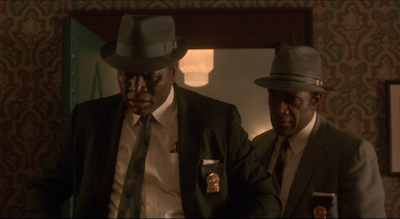 But this one focuses on the criminals and victims, with the two detectives circling in and out as supporting players. And a cool thing about that is that they don’t have to be played by some superstars of 1991 – instead they’re comedian George Wallace (later the mayor in BATMAN FOREVER) and Stack Pierce (TROUBLE MAN, VICE SQUAD). With their droll delivery I could see one of them being played by Bill Duke, but he was busy directing this, in his feature film debut after a decade of helming TV shows (Miami Vice, Hunter) and one TV movie (JOHNNIE MAE GIBSON: F.B.I.).
But this one focuses on the criminals and victims, with the two detectives circling in and out as supporting players. And a cool thing about that is that they don’t have to be played by some superstars of 1991 – instead they’re comedian George Wallace (later the mayor in BATMAN FOREVER) and Stack Pierce (TROUBLE MAN, VICE SQUAD). With their droll delivery I could see one of them being played by Bill Duke, but he was busy directing this, in his feature film debut after a decade of helming TV shows (Miami Vice, Hunter) and one TV movie (JOHNNIE MAE GIBSON: F.B.I.).
This is a noir story about a femme fatale trying to run off with some loot, hiding out with an unsuspecting schmo, and pulling him into her trouble when it catches up with her. Then it becomes a buddy movie between the schmo (a teetotaling virgin) and his estranged hustler step brother trying to deal with the situation. And those standard story elements are made lively by the funny personalities of the characters (both major and minor), and the visually rich setting of ‘50s Harlem (filmed in Cincinnati).
The lady is Imabelle, played spectacularly by Robin Givens (at that time finishing up Head of the Class and being disrespected by the press after her divorce from Mike Tyson). We meet her in Natchez, Mississippi as the one woman with a Black gang meeting with a bunch of white rednecks in a barn to try to unload some gold ore they robbed straight from a mine.
I love how this scene establishes that Imabelle should be the one in charge here, but is disregarded because she’s a woman. The first laugh of the movie is when she says to the leader of the gold launderers (John Seitz, THE PROWLER, G.I. JANE), “Lester, you tryin’ to cheat us, you cheap bastard,” and her boyfriend Slim (Badja Djola, “Half Dead” from PENITENTIARY) scolds, “Hush up baby girl, I’ll handle this”… only to repeat what she just said almost word-for-word.
Check out how Slim is framed between the shadows of Imabelle and Lester, the two people who should actually be having this conversation.
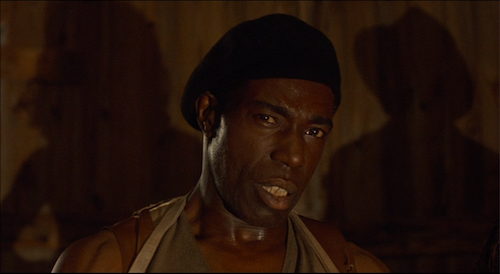
Imabelle is tough, but doesn’t agree with Slim wanting to kill people or throw acid in their faces. So she doesn’t try too hard to help when cops show up, bullets start flying and the opportunity presents itself to drive off with the chest full of gold.
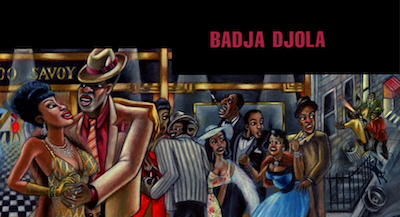 Going straight from that bloody opening to the title and a jazzy Elmer Bernstein theme over paintings of Harlem life (by someone named Joe Bachelor) tells you this is gonna be a lively one.
Going straight from that bloody opening to the title and a jazzy Elmer Bernstein theme over paintings of Harlem life (by someone named Joe Bachelor) tells you this is gonna be a lively one.
Then we meet the schmo, Jackson (Forest Whitaker three years after BIRD and BLOODSPORT, and one year before THE CRYING GAME). He’s a comically uptight nerd who wakes up in his pajamas beneath portraits of Jesus and his brick-jawed late mother (which will be a great running gag), and immediately prays to God to thank Him for the amount of money he’s saved up from his job at the funeral home. “Thank you for making me provident, and for not putting obstacles in my way, such as… women. Amen.”
Of course that changes when he spills a drink (of water) on Imabelle at the Annual Undertaker’s Ball, and she’s looking for a good mark because she has no money for a hotel. The opposing forces of her megaton va-va-voom powers and his exaggerated dorkiness make for a really funny sequence as she tries repeatedly to seduce him and he keeps not getting it or pretending it’s not happening, much to her amusement. He plies her with boring undertaker work talk and looks to the portrait of Jesus for support while acting casual about her laying on his bed caressing his lower lip (and elsewhere) with her toes. Nobody could deny Givens’ perfection as a bombshell in this movie, swinging her hips and crawling around like a stalking tiger in a red dress they literally sewed onto her, but Exhibit A that her talents go deeper than that is her response when he stops an autopsy story to ask, “You probly ain’t never seen a body, right?”

Despite her best efforts it takes her like 12 hours to finally get him into bed with her (still wearing his bow tie and sock garters), and then he thinks they should get married.
“Maybe we should just try this out for the weekend?” she offers.
“You mean… live together in sin.”
“Yeah. Why not?”
Pretty soon Slim and the gang catch up with her, and she helps them scam Jackson, while hiding from them, but not us, that she actually likes him. Ripped off, threatened by Slim (disguised as a marshal), and believing Imabelle has been abducted, Jackson swallows his pride and enlists the help of his numbers-runner step brother Goldy (Gregory Hines right after EVE OF DESTRUCTION). Meanwhile, Slim and friends try to make a deal with Easy Money (Danny Glover, shortly after PREDATOR 2, around the same time as the MC Hammer “2 Legit 2 Quit” video), a crime boss who’s always carrying around a Pomeranian.
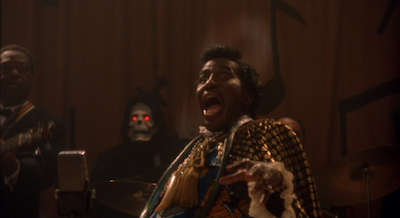 It mostly takes place in hotel rooms, small apartments and bars. One of the main locations is a place called The Royale, where there’s dancing every night and Jackie Wilson headlining, according to the sign. We never see him, but to my to my surprise after Screamin’ Jay Hawkins’ name appears on the marquee we see the man himself performing “I Put a Spell On You” at the ball. Yes, the actual Screamin’ Jay Hawkins (MYSTERY TRAIN, PERDITA DURANGO), portraying himself when he was 35 years younger. Why not?
It mostly takes place in hotel rooms, small apartments and bars. One of the main locations is a place called The Royale, where there’s dancing every night and Jackie Wilson headlining, according to the sign. We never see him, but to my to my surprise after Screamin’ Jay Hawkins’ name appears on the marquee we see the man himself performing “I Put a Spell On You” at the ball. Yes, the actual Screamin’ Jay Hawkins (MYSTERY TRAIN, PERDITA DURANGO), portraying himself when he was 35 years younger. Why not?
Goldy gets help from Big Kathy (Zakes Mokae, WATERWORLD, VAMPIRE IN BROOKLYN), a really cool character who runs a brothel as a woman, but goes by “he” and sometimes goes out into the world dressed as a man. The world of the movie is not tolerant of Kathy – Coffin Ed calls him a “fruit,” and he ends up getting killed. But he’s absolutely painted in a positive light, both as a capable partner and someone who Goldy mourns as “my real family” and “the only person I care about in this whole fuckin world.” There’s also a cool hotel clerk (Beatrice Winde, THE TAKE OF PELHAM ONE TWO THREE, MALCOLM X) who dresses coded male, other than some fingernail polish. I think this is a reflection of Harlem in the ’50s and of the type of characters who showed up in Himes’ work, but its matter-of-factness ends up feeling a little ahead of the curve for a mainstream movie in the homophobic ’90s.
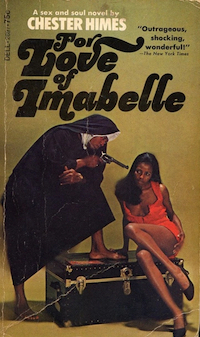 There are other colorful characters in the neighborhood, most of them funny. We get alot of riffing from Jackson’s “blasphemin’ Philistine” co-workers Smitty and Louis (T.K. Carter from THE THING and a baby-faced Wendell Pierce). And Jackson’s landlady Mrs. Canfield (Helen Martin, beloved angry grandma from 227 and later DON’T BE A MENACE TO SOUTH CENTRAL WHILE DRINKING YOUR JUICE IN THE HOOD) proves in one scene that she can get a laugh with a single grunt.
There are other colorful characters in the neighborhood, most of them funny. We get alot of riffing from Jackson’s “blasphemin’ Philistine” co-workers Smitty and Louis (T.K. Carter from THE THING and a baby-faced Wendell Pierce). And Jackson’s landlady Mrs. Canfield (Helen Martin, beloved angry grandma from 227 and later DON’T BE A MENACE TO SOUTH CENTRAL WHILE DRINKING YOUR JUICE IN THE HOOD) proves in one scene that she can get a laugh with a single grunt.
I also dig Jackson’s rivalry with Claude X (Willard E. Pugh, THE HILLS HAVE EYES PART II, THE GUYVER), who he gets mad at for saying “As-salamu alaykum” to him. You realize pretty quick that he’s just like Jackson except he’s nerdy for Islam instead of Christianity.
It’s a great (and strange) performance by Whitaker. His goofy voice and demeanor are consistently funny, and he somehow manages to “man up” for Imabelle without betraying that or turning macho. Even when he wears a comical fake mustache and gets drunk it still feels more like a crime movie with funny characters than a straight up comedy. It’s definitely an odd mix of tones, and it’s possible that wasn’t as intentional as I assumed. In a 2010 BBC interview, producer Stephen Woolley (MONA LISA) said that about halfway through production he realized that while he had sold the movie as a comedy Duke told him that “we’re not making no god damn comedy.” But I think it’s likely the producer just didn’t get what Duke meant. It’s not as if they just added in laughs later to balance it. The humor is built into to the characters, performances and premise, and at the time Woolley correctly raved about Duke’s approach to Premiere: “There’s very little sarcasm or cynicism here—his vision of the film doesn’t condescend, like a lot of Hollywood movies, and there’s no wink-wink, like with Eddie Murphy or Robert Townsend.”
Though Wooley is white, he was wise enough to know, as he told Premiere, “It would be an absolute dishonor to Himes for a white to direct it. It would be folly, madness, to make it without a Black director.” They consulted with Whitaker – who’d been in a 1984 Hill Street Blues episode directed by Duke – about who to choose. According to Woolley they were specifically looking for a journeyman: “A lot of the younger Black directors are auteurists whose work is built around personal experiences. We needed someone who was older and secure enough to collaborate and make a picture that we could distribute widely, but who still had a passion for the material.”
I guess that just means he didn’t want to ask Spike Lee. I assumed he was including John Singleton and Matty Rich, but their first films didn’t come out until later that summer.
Judging from the theatrical poster, Miramax or somebody wanted people to think it was a broader comedy than it really was. But I think Duke got it just right. My sense is that the tone is accurate to Himes, but I’ve only read one of his books (and not this one), so I’ll say that this is funny similar to the way Elmore Leonard is funny. And other than Slim and his enforcers, pretty much everyone is likable. I call Imabelle a femme fatale because she fits into that tradition, but the romance is genuine and sweet. Even bad guy Danny Glover is sympathetic with that little dog of his and his talent for messing with Slim by pretending to be oblivious about his possessiveness of Imabelle.
Executive producer William Horberg had been a fan of the Himes novels and acquired the film rights years earlier. He’d go on to produce MIAMI BLUES, SYNECDOCHE NEW YORK and many other fine films, but at the time he was a total novice. According to a 2008 blog post, he knew “next to nothing about producing a movie,” so it made sense to him to get an actor who’d never written anything before – John Toles-Bey, who plays Jodie in the movie and had been in MIDNIGHT RUN and OUT FOR JUSTICE – to do the script. It was later rewritten by credited Bobby Crawford (227) and uncredited Topper Lilien & Carol Cartwright (DUNGEONS & DRAGONS).
They found a pretty solid indie film crew to put behind the camera. Editor Curtiss Clayton had done DRUGSTORE COWBOY and the “Welcome to the Jungle” video. And also HALLOWEEN 4. Director of photography Toyomichi Kurita (TROUBLE IN MIND, POWWOW HIGHWAY, COOKIE’S FORTUNE, SUKIYAKI WESTERN DJANGO) gives it a nice look that I think could at times be described as hazy afternoon noir. Sure, there’s some night time and some shadows, but what sticks with me is that feeling of warm sun seeping in through windows.
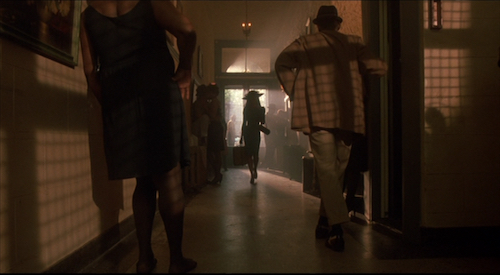
A RAGE IN HARLEM did not receive great reviews, and it might not have been profitable, since it only made a few million more than its budget at the box office. I definitely don’t think Givens received the credit or opportunities she deserved for the performance, but at least it didn’t kill her big screen career (she co-starred in BOOMERANG the next year). Arguably the film’s biggest effect on culture – besides its dialogue being sampled on a couple Ice Cube songs and I think Public Enemy? (“And I think you don’t know what the fuck it is you talkin about!”) – was launching the directorial career of Bill Duke. The next year he did DEEP COVER, which was more commercial with its modern setting, more traditional protagonist and historic soundtrack (it introduced the world to Snoop Dogg).
That one was better received, and is about to get some much-deserved renewed interest as it enters the Criterion Collection in July. But I believe A RAGE IN HARLEM is also worthy of, and more in need of, re-evaluation. I’m glad I arbitrarily chose it as the official kick off of Summer Movie Season 1991.


























May 3rd, 2021 at 11:29 am
Still have the main title theme on many a writing mix.